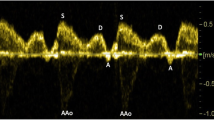Abstract
Objective
Our objective was to establish reference values for ductus venosus, inferior vena cava and hepatic vein flow velocities during ventricular systole (S-wave) and diastole (D-wave), the lowest forward velocity during atrial contraction (a-wave), the intensity-weighted mean flow velocity (Vmean) and different calculated indices.
Methods
Venous flow velocity waveforms were obtained from 329 singleton pregnancies at 20–42 weeks of gestation by pulsed-wave color Doppler. Reference values were constructed by means of a quadratic regression model after logarithmic transformation of original data.
Results
With advancing gestational age the peak velocity index for the vein (PVIV) and pulsatility index for the vein (PIV) decreased whereas blood flow velocities increased. Blood flow velocities were highest in the ductus venosus and lowest in the right hepatic vein. Values for PVIV and PIV were highest in the hepatic vein and lowest in the ductus venosus. During atrial contraction there was a blood flow towards the fetal heart in the ductus venosus, whereas in the inferior vena cava and in the hepatic vein blood flow was either in the opposite from the fetal heart (reverse flow), or there was absent flow (zero flow) or flow was towards the fetal heart (positive flow).
Conclusions
The reference ranges and calculated velocities established in this study may be utilized in studies dealing with the role of ductus venosus and inferior vena cava blood flow in fetuses with chromosomal abnormalities or congenital heart disease as well as hypoxic conditions. We speculate, that the reduction in PVIV and PIV with advancing gestational age may reflect a decrease in cardiac afterload as a result of maturation of diastolic ventricular function.



























Similar content being viewed by others
References
Bahlmann F, Wellek S, Reinhardt I, Merz E, Steiner E, Welter C (2000) Reference values of ductus venosus flow velocities and calculated waveform indices. Prenat Diagn 20:623–634
De Vore GR, Horenstein J (1993) Ductus venosus index: a method for evaluating right ventricular preload in the second trimester fetus. Ultrasound Obstet Gynecol 3:338–342
Hecher K, Campbell S, Snijders R, Nicolaides K (1994) Reference ranges for fetal venous and atrioventricular blood flow parameters. Ultrasound Obstet Gynecol 4:381–390
Hecher K, Campbell S, Doyle P, Harrington K, Nicolaides K (1995) Assessment of fetal compromise by Doppler ultrasound investigation of the circulation. Circulation 91:129–138
Huisman TWA, Stewart PA, Wladimiroff JW (1991) Flow velocity waveforms in the fetal inferior vena cava during the second half of normal pregnancy. Ultrasound Med Biol 17:679–682
Huisman TWA, Gittenberger-De Groot AC, Wladimiroff JW (1992) Recognition of a fetal subdiaphragmatic venous vestibulum essential for fetal venous Doppler assessment. Pediatr Res 32:338–341
Huisman TWA, Stewart PA, Wladimiroff JW (1992) Ductus venosus blood flow velocity waveforms in the human fetus—a Doppler study. Ultrasound Med Biol 18:33–37
Huisman TWA, van den Eijnde SM, Stewart PA, Wladimiroff JW (1993) Changes in inferior vena cava blood flow velocity and diameter during breathing movements in the human fetus. Ultrasound Obstet Gynecol 3:26–30
Huisman TWA, Brezinka C, Stewart PA, Stijnen T, Wladimiroff JW (1994) Ductus venosus flow velocity waveforms in relation to fetal behavioural states. Br J Obstet Gynaecol 101:220–224
Kanzaki T, Chiba Y (1990) Evaluation of the preload condition of the fetus by inferior vena cava blood flow pattern. Fetal Diagn Ther 5:168–174
Kiserud T, Eik-Nes SH, Blaas HGK, Hellevik LR (1991) Ultrasonographic velocimetry of the fetal ductus venosus. Lancet 338:1412–1414
Kiserud T, Eik-Nes SH, Hellevik LR, Blaas HG (1992) Ductus venosus—a longitudinal Doppler velocimetric study of the human fetus. J Matern Fetal Invest 2:5–11
Kiserud T, Eik-Nes SH, Blaas HG, Simensen B (1994) Ductus venosus blood velocity and the umbilical circulation in the seriously growth-retarded fetus. Ultrasound Obstet Gynecol 4:109–114
Nakata M (1996) Doppler velocimetry waveforms in ductus venosus in normal and small-for-gestational age fetuses. J Obstet Gynaecol Res 22:489–496
Reed KL, Sahn DJ, Scagnelli S, Anderson CF, Shenker F (1986) Doppler echocardiographic studies of diastolic function in the human fetal heart: changes during gestation. J Am Coll Cardiol 8:391–395
Reed KL, Appleton CP, Anderson CF, Shenker L, Sahn DJ (1990) Doppler studies of vena cava flows in human fetuses. Insights into normal and abnormal cardiac physiology. Circulation 81:498–505
Rizzo G, Arduini D, Romanini C (1992) Inferior vena cava flow velocity waveforms in appropriate- and small-for-gestational-age fetuses. Am J Obstet Gynecol 166:1271–1280
Rizzo G, Arduini D, Caforio L, Romanini C (1992) Effects of sampling sites on inferior vena cava flow velocity waveforms. J Matern Fetal Invest 2:153–156
Rizzo G, Capponi A, Arduini D, Romanini C (1994) Ductus venosus velocity waveforms in appropriate and small for gestational age fetuses. Early Hum Dev 39:15–26
Rizzo G, Capponi A, Talone PE, Arduini D, Romanini C (1996) Doppler indices from inferior vena cava and ductus venosus in predicting pH and oxygen tension in umbilical blood at cordocentesis in growth-retarded fetuses. Ultrasound Obstet Gynecol 7:401–410
Van Splunder P, Huisman TWA, De Ridder MAJ, Wladimiroff JW (1996) Fetal venous and arterial flow velocity wave forms between eight and twenty weeks of gestation. Pediatr Res 40:158–162
Author information
Authors and Affiliations
Corresponding author
Rights and permissions
About this article
Cite this article
Axt-Fliedner, R., Wiegank, U., Fetsch, C. et al. Reference values of fetal ductus venosus, inferior vena cava and hepatic vein blood flow velocities and waveform indices during the second and third trimester of pregnancy. Arch Gynecol Obstet 270, 46–55 (2004). https://doi.org/10.1007/s00404-003-0586-6
Received:
Accepted:
Published:
Issue Date:
DOI: https://doi.org/10.1007/s00404-003-0586-6




